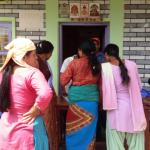 More than 70 percent of Nepal’s population works in agriculture, yet this South Asian country struggles to produce an adequate and affordable supply of food. Weak growth in agricultural production and low crop yields have weakened rural economies, increasing urban and international migration and straining the ability of families to avoid malnutrition.
More than 70 percent of Nepal’s population works in agriculture, yet this South Asian country struggles to produce an adequate and affordable supply of food. Weak growth in agricultural production and low crop yields have weakened rural economies, increasing urban and international migration and straining the ability of families to avoid malnutrition.
Two out of every three Nepalese suffer from food insecurity at some time during the year and the prevalence of stunting for Nepal stands at 37.4 percent nationally. The underlying causes of hunger, poverty and undernutrition in Nepal include low agricultural productivity, limited livelihood opportunities, weak market connections and coordination, inadequate production and consumption of highly nutritious foods, poor infrastructure and inadequate government resources.
Nepal has the agroecological potential to produce a food surplus and has an excellent track record in piloting ground-breaking development programs. Multi-sector efforts incorporate best practices, such as conservation agriculture, crop rotation and small-scale irrigation, though potential is high for activities to stimulate agricultural production, increase incomes, improve nutrition and boost food security.
Learn more from Feed the Future.



